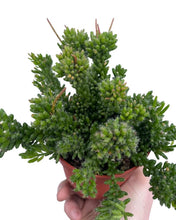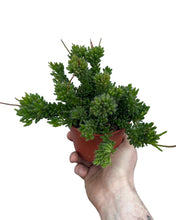Rhipsalis mesembryanthemoides is part of the Cactaceae family and its native range is SE. Brazil. This plant is on the IUCN list as critically endangered due to urbanisation, all that is left of the species are plants growing on trees in public parks.
Rhipsalis mesembryanthemoides have strong stems with tiny clumping branchlets. Initially this plant grows erect, later becoming pendant with branches reaching up to 20cm long. Flowers are pink-white and are solitary borne laterally on the shorter segments, they bloom in winter.
Genus name comes from the Ancient Greek, meaning wicker work, this is in reference to the branches which appear to interlace as they hang. The specific epithet is from the Greek mesēmbria meaning midday and ánthemon meaning flower.
Pot: ø 10.5cm
Height: Approximately 15cm from base of pot.
Light: Bright indirect light, meaning the plant sees the sun for 0-4 hours per day - this could be through trees or a translucent curtain, it’s important for the plant to see the sky in order to thrive. In its natural environment this plant would receive dappled light.
Water: With adequate light and a well draining potting mix, allow the top two inches to dry out before watering.
Potting mix: A well draining mix composed of a small amount of coco coir, perlite or vermiculite, orchid bark, horticultural grit and worm castings; you could also add some horticultural charcoal to this epiphytic mix.
Fertilising: Feed your plant every few waterings during the growing season or when you observe active growth. You can dilute fertiliser to half the recommended amount but never add more.
Temperature: 18-24˚C.
Humidity: Rhipsalis mesembryanthemoides would prefer higher humidity but do well to adapt to average home humidity. You can increase humidity by placing the plant on a watered pebble tray or using a humidifier.
Rhipsalis mesembryanthemoides are non-toxic.



